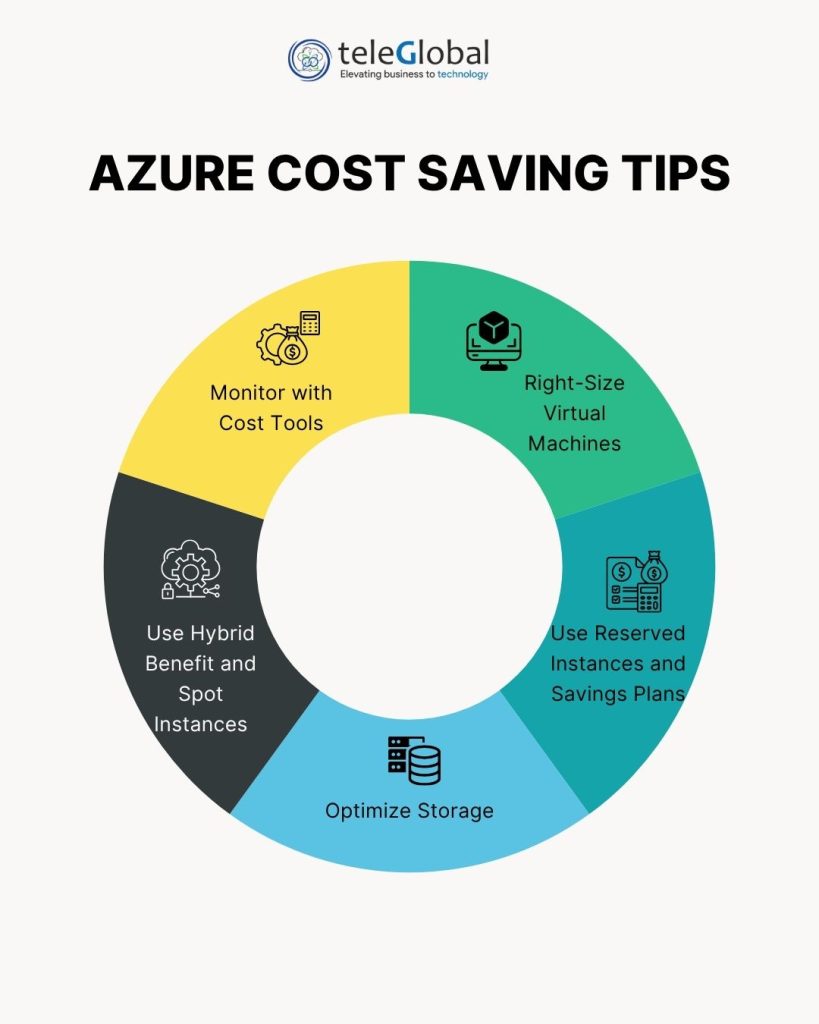
| Author: Ashish Kumar | Published: 11-Sept-2025 |
Many companies use Microsoft Azure cloud to run key services. It offers scale, security, and strong global reach. But with all its benefits, cost control is still a major problem.
Cloud waste is high. Studies show more than 30% of cloud spend is wasted. This waste comes from unused machines, poor storage management, or lack of monitoring.
Business leaders want to cut costs without hurting service speed. The answer lies in Azure cost optimization. By using smart steps, you can lower spend and keep strong Azure performance.
This guide will cover five proven ways. It will also explain what is Microsoft Azure, why cost control matters, and how companies can get more value from Azure Microsoft services.
Microsoft Azure is a public cloud platform from Microsoft. It provides over 200 services. These include computing, storage, networking, security, databases, DevOps, and AI.
Companies use Microsoft Azure cloud computing to run apps, store data, and manage IT systems. It works on a pay-as-you-go model. This means you only pay for what you use.
Some common uses of Microsoft Azure cloud platform are:
The platform is a direct rival to AWS and Google Cloud. Many compare Microsoft Azure vs AWS pricing and features before choosing.
Microsoft Azure pricing is flexible but can grow fast. Without control, monthly bills can shock IT teams.
Key pain points for businesses are:
These problems lead to wasted funds. In 2025, global cloud waste may reach $44 billion. For many, this is money that could go to new projects instead.
This is why Azure cost saving tips are not just nice to have. They are vital for IT and finance leaders.

The biggest cost driver in Azure is virtual machines. Many are oversized or left idle.
Steps to fix this:
Azure Advisor provides real insights here. It recommends changes based on real data. Following its advice can cut spend by 20 to 30%.
Right-sizing does not lower quality. It ensures you match resources to real demand. This keeps Microsoft Azure cloud efficient and cost-friendly.
Some workloads run every day with no breaks. Paying hourly for them is wasteful.
For these, Azure offers reserved instances. You commit to one or three years. In return, you get up to 72% savings.
Azure also has savings plans. These apply to compute use and save up to 65%.
Good fits for reserved or savings plans:
These options make Microsoft Azure cloud platform more predictable in cost. Finance teams prefer them because they reduce surprise bills.
Storage is often overlooked in Azure cost optimization. Yet it can consume huge budgets if unmanaged.
Ways to manage better:
Tools like Microsoft Azure storage explorer make it easier to track and manage files.
Archive storage can cost 80% less than hot storage. By moving old files, companies save thousands yearly.
Microsoft offers two smart options to cut spend:
Azure Hybrid Benefit lets you use existing Windows or SQL licenses. This reduces software costs. Companies can save up to 55% on SQL and 40% on VMs.
Spot instances provide extra savings. These VMs are cheaper but can be interrupted. They are ideal for:
Together, these features provide strong Microsoft Azure optimization. Businesses keep performance where needed and save on flexible tasks.
Manual checks are not enough for Microsoft Azure pricing. Azure offers built-in tools for better tracking.
Key tools:
Companies that use these tools save 15 to 25% on average. They also gain better visibility, which is vital for IT and finance teams.
Many companies now adopt FinOps. This is a way to manage cloud costs with shared responsibility.
With FinOps, IT, finance, and business teams work together. They set budgets, track spend, and enforce rules.
Some use “FinOps as code”. These are policies that run inside software pipelines. For example, a rule might stop a server at night. This saved one retailer 6% of costs.
This approach makes Azure cloud cost management part of daily work.
To optimize spend, you must know the basics. Microsoft Azure fundamentals cover:
Understanding these helps teams use the right service at the right tier. For example, choosing a lower tier for dev work while keeping production on premium.
Strong security is not optional. Many think tighter security means higher cost. But in Azure, smart security can also cut spend.
Examples:
Good security reduces risk of outages and wasted resources. This supports both cost and performance.
Leaders often compare Microsoft Azure vs AWS. Both are strong platforms with wide services.
Azure is often seen as more cost-friendly for Windows and SQL users. This is due to Hybrid Benefit. AWS may have edge pricing in other areas.
The real answer depends on workload. Companies should compare services side by side. For many, Microsoft Azure cloud computing offers better savings when optimized.
By applying these five steps, companies gain:
These benefits show why cost control is central to long-term Microsoft Azure cloud success.
Microsoft Azure cloud platform offers power and flexibility. But without cost control, budgets can spiral.
The five best steps to reduce Azure costs are:
At TeleGlobal International, we help businesses make the most of Microsoft Azure services. We build strategies that cut costs and keep performance strong. Our goal is simple: deliver clarity, savings, and better results for your cloud journey.
It is a public cloud platform offering over 200 services.
Hosting apps, databases, AI tools, DevOps, and storage.
Resize VMs, use reserved plans, clean storage, and monitor spend.
Pay-as-you-go, reserved plans, and savings plans offer options for all needs.
It depends on workload, but Hybrid Benefit gives Azure an edge for Windows and SQL.
Azure Cost Management, Billing, Advisor, and automation policies.
Yes, with Microsoft Azure certifications and training in Microsoft Azure fundamentals.
 close
close

Hi there! At TeleGlobal, we turn your cloud vision into AI-accelerated reality. What challenge can we help you solve?
Powered by ![]() teleBot
teleBot